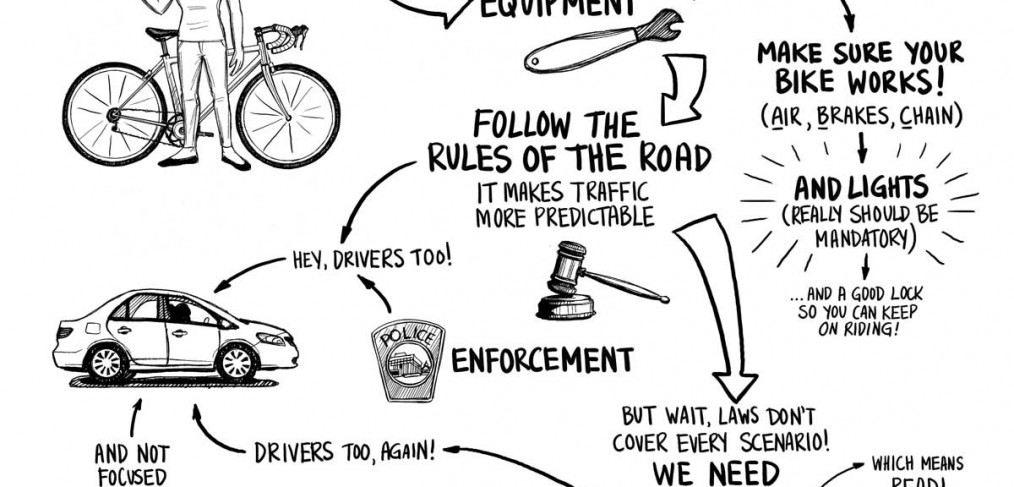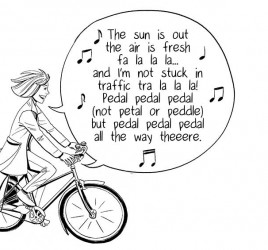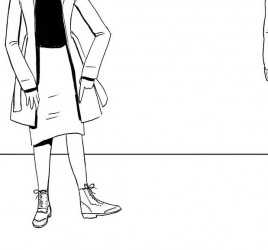
Serious about Safety
Every bike commuter knows is that safety is a complicated issue. They face it every day. However, some safety campaigns focus entirely on helmets. But that means there’s been a crash. What if it could have been prevented? Wouldn’t that be safer?
There’s many points along the way where an individual, a community, and a city, can prevent more tragedies from happening. Helmet or not, when you put a car against a vulnerable road user, you know who the victim will be. Cities need to get real about safety. No excuses.





Safety campaigns in The Netherlands never, ever mention helmets. Instead, they put the blame squarely where it belongs: upon dangerous, reckless, negligent car drivers. Here`s one example:
http://www.youtube.com/watch?v=y60YQOzNWYE&feature=plcp
To quote one Dutch police officer: “When someone is shot, we don`t tell everyone else to wear bulletproof vests. Instead we go after the gunman.“
Well, I’ve seen my name mentioned a few times in these ocmments and maybe I’ll get to responding later, but let me comment on something in the cartoon itself: “And Lights: really should be mandatory.”
They are mandatory. It’s in the law of every state. Bikeytface, I like your cartoons, but you could stand to inform yourself better.
Actually, allow me to me propose something to you: a ride on the back of my tandem so you can see how a person who has been described by one of your commenters as promoting a “dying gasp” has been riding safely for 40 years in Boston urban traffic.
Just going on my leaking memory, but my impression is that the worst accidents in Sonoma County are in the _rural_ areas. In broad daylight. These are certainly the ones that make an impression on me.
They are?!? I thought they were only mandatory at night. Automobile lights, by contrast, are required to be built in and are mandatory in some daylight situations, such as rain.
It was unclear to me if she meant all the time, or just at night. It’s certainly the case that items #1 and #2 in any bicycle related safety screed are helmets-helmets-helmets and not stopping, even though lack of proper lights plays a huge role in safety (when did you last see reported whether or not a crash victim had lights on their bike, hmmm?) I started using hub-driven lights with no off switch a few years ago, and put some like that on my kids’ bikes, and it’s clearly the way to go for idiot-proof lights.
I’m also surprised, give how the VC method emphasizes the importance of visibility (being where people are looking, acting in particular predictable ways), that I don’t hear much official promotion for bicycle daytime running lights. It works for motorcycles and cars in the daytime; why not bicycles too?
Breaking news… I see that some more peer-reviewed research at a major university concludes that proper protected cycle lanes are safer. And that crossing railway or streetcar tracks is a hazard.
A bit duhhh from me and my friends, but being able to quantify the safety vs. hazard helps to justfy and prioritize the necessary spending to remove the hazards and increase safety.
See:
http://ajph.aphapublications.org/doi/abs/10.2105/AJPH.2012.300762?journalCode=ajph
Shhhh!
The VCers might be having convulsions over this:
http://www.theatlanticcities.com/commute/2012/10/dedicated-bike-lanes-can-cut-cycling-injuries-half/3654/
http://dc.streetsblog.org/2012/10/22/study-protected-bike-lanes-reduce-injury-risk-up-to-90-percent/
Great post! The focus on helmets is a source of great frustration for many cycling advocates.
Studies show that bike-lane miles are the number one factor that correlates with high cycling rates and that the health benefits of cycling outweigh the dangers 10 to one. Studies of crashes also show that many crashes are associated with dangerous practices, such as wrong-way riding or riding at night without lights.
The point is to focus on what works to prevent crashes, not to assign blame after the fact, which seems to be the main function of helmets (reporters always ask about helmets even when there is no head injury).
I am waiting for newspaper reporters to blame shooting victims for not wearing bulletproof vests.